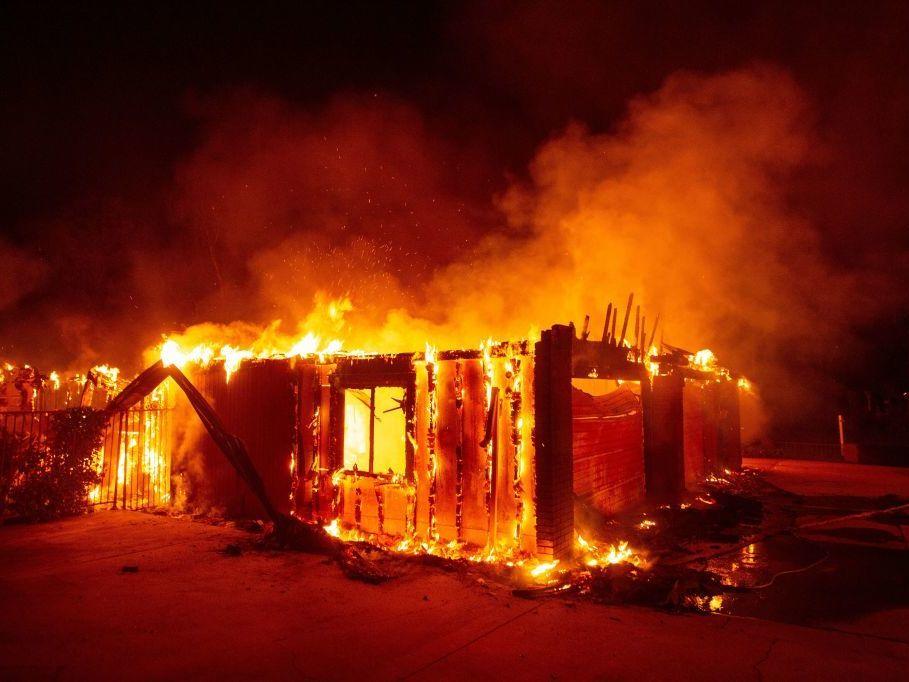Section Branding
Header Content
Fireproofing your home isn't very expensive — but few states require it
Primary Content
Increasingly destructive wildfires have consumed tens of thousands of homes over the past decade, but few states have codes that require houses be built with fire-resistant materials. Now, a new study shows that enhancing a new home's wildfire resistance adds minimal cost to an overall construction project.
Looking at home construction in California, the Insurance Institute for Business & Home Safety (IBHS) finds that installing additional wildfire safety measures, beyond the state's current wildfire building codes, adds from 2%-13% to the cost of construction. Under state law, homes in risky areas already must be built with fire-resistant roofing, siding and decking.
While there's no guarantee a home will survive a wildfire, fire-resistant materials are more likely to withstand the onslaught of embers that are often blown far ahead of a wildfire. One study found that homes that met wildfire codes were 40% less likely to be destroyed, compared to older homes.
Still, despite recommendations from fire officials, efforts to pass wildfire building codes have been stymied in many other Western states over cost concerns from the building and real estate industries. The new study from IBHS and Headwaters Economics, a land use think tank, is meant to provide concrete data for policymakers, and it appears to undercut industry claims of prohibitive costs.
"We show that a whole lot of these actions have fairly negligible cost," says Roy Wright, CEO of IBHS. "That's the kind of investment that's assuredly going to pay off if a wildfire approaches a community."
Enhancing a home's wildfire safety can be cost-effective
In wildfires, it's not the wall of flames that engulfs most homes. Instead, it's the rain of embers carried by the wind that lands on a house, catching a wood shingle, a pile of leaves in the gutter or even getting sucked into the attic through a vent.
California's wildfire building code, passed in 2007, was designed to reduce a home's risk of igniting. Wood roofs aren't allowed. Decks and siding must be fire-resistant. Attic vents need to be covered in mesh to prevent embers from getting through. Homes must also have "defensible space," limiting the amount of flammable vegetation immediately around it.
Building a new home to meet those wildfire standards can cost roughly the same as a house that doesn't meet them, according to a 2018 study by IBHS and Headwaters Economics. That's because some fire-resistant materials are more affordable than their counterparts. Another study from the National Association of Home Builders found the costs range from $1,827 to $44,888, depending on whether more costly siding material is chosen for the house.
Still, as wildfires become increasingly destructive in a hotter, drier climate, some fire experts are recommending even more be done. California is currently developing new defensible space rules to require an ember-resistant zone within five feet of a house. That could mean ensuring the area has a non-combustible material like pea gravel, instead of mulch.
The IBHS study finds that meeting that new requirement, plus enclosing the area under the deck so embers don't fly under it, would cost roughly $2,780. For homeowners who want to reduce their risk even more, using "optimum" wildfire building materials like installing a metal roof, ranges from $18,180 to $27,080.
Wildfire building codes stalling in other states
While homes can be retrofitted after they're built to improve their wildfire risk, installing fire-resistant materials at the outset is far more cost-effective, building experts say. Homeowners may also see lower insurance premiums, since many insurance companies are beginning to reduce rates for homeowners with wildfire-resistant construction.
But in many states, some with devastating wildfires in recent years, efforts to pass building codes similar to California's have been fought by the building industry.
Only three other states, Nevada, Utah and Pennsylvania, have instituted statewide wildfire building codes. Oregon recently passed legislation to develop new wildfire standards after previous efforts were defeated. In 2018, homebuilders objected to mandatory wildfire building codes, so codes were made optional for cities, meaning that thousands of homeowners who lost their homes to wildfires in recent years weren't required to build safer structures.
In Colorado, wildfire experts recommended almost a decade ago that a statewide building code be passed. While a handful of cities have their own, many do not, creating a patchwork of regulations. But the Colorado Association of Home Builders pushed back, telling NPR in 2020 that they believe building codes are best developed at the local level.
After experiencing the most destructive wildfire in Colorado history, some legislators made a new push this year to give regulators the power to create a statewide code. The effort failed yet again in May after objections from the Colorado Municipal League and others over costs and local control.
Driven by a national housing shortage, many homeowners unknowingly buy new houses in the "wildland-urban interface," a zone particularly at risk of burning in many states. About 60 million homes in the U.S. are within an area that's already burned or are within a kilometer of previous fire.
"I think it's downright irresponsible for community leaders to not lean into this question about good construction at this point," Wright says. "They need to make sure people have homes that can withstand what we know is coming."
Copyright 2022 NPR. To see more, visit https://www.npr.org.

